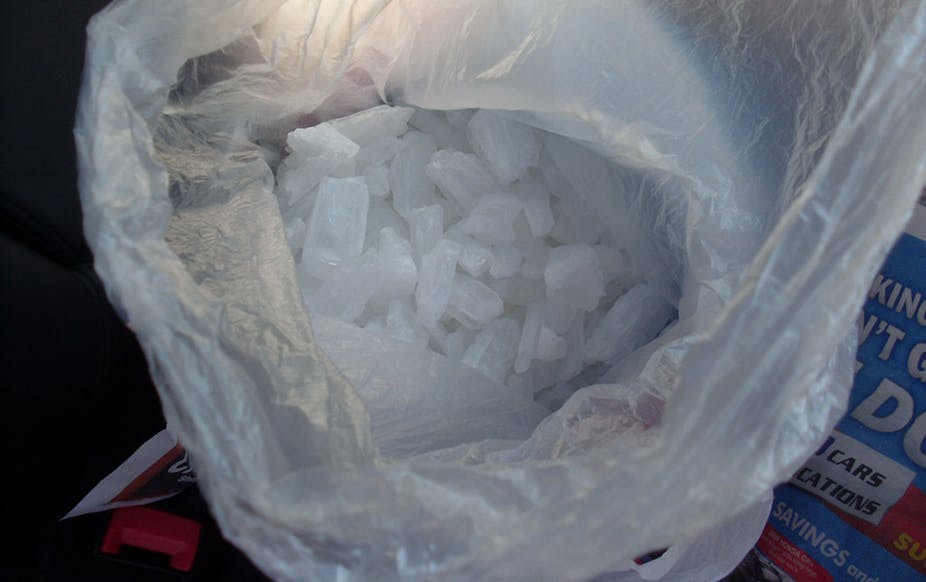The 2012-13 Australian Crime Commission (ACC) Illicit Drug Data Report, released earlier this week, provides mounting evidence that crystal meth is becoming a large-scale problem for law enforcement and health authorities in Australia.
Methamphetamine hydrochloride, better known as crystal meth or ice, first became a factor in Australia’s illicit drug scene in the mid-2000s. The United Nations Office of Drugs and Crime (UNODC) currently classes crystal meth as an “imminent threat” due to increased seizures worldwide, particularly in east and southeast Asia.
On releasing the report, acting ACC head Paul Jevtovic described crystal meth as a “national concern”, likening it to the crack cocaine scourge in the United States in the 1980s. Rates of use and detection are rising significantly.
Crystal meth is just one of a number of amphetamine-type stimulants (ATS) that are competing for market share against more traditional illicit drugs such as cocaine and heroin. At least one study has shown that the use of crystal meth in Australia has increased by 10% since 2011. And while the use of some other ATS has declined, the use of crystal meth remains at a high level and continues to increase.

Current threat assessment
The ACC report provides sombre reading. In the year 2012-13, the number and weight of ATS (excluding MDMA/ecstasy) detections at the Australian border increased and are the highest on record.
The UNODC estimates that some 90% of ATS are manufactured locally. However, for crystal meth, the situation is different; a higher proportion is imported.
Significant border detections of crystal meth in 2012-13 included 58 kilograms of crystal meth in February 2013, declared as metabisulphite, via sea cargo from China to Sydney and 306 kilograms of crystal meth in July 2012, concealed in 3200 terracotta pots, via sea cargo from Thailand to Sydney. This trend matches the previous year, when crystal meth accounted for some of the biggest seizures at the Australian border.

Law enforcement responses
Drug trafficking is characterised by a high level of free enterprise and in some respects it does not suffer from the constraints of legitimate markets. “Success” in the drug business focuses on elements such as access to working capital, availability of raw materials, manufacturing facilities, reliable shipping, wholesale distributors and a marketing arm and retail.
Recently, law enforcement efforts have moved from focusing on the ends – that is, drug users – to the means: raw materials and manufacturing facilities. The efforts are aimed at undermining the business models of drug traffickers. Evidence of this can be seen in the number of detections of precursor chemicals at the Australian border increasing by 11% in 2012-13.
The number of clandestine labs detected in Australia over the last decade has doubled. In 2012-13, 330 clandestine labs were discovered in Queensland: 43% of the Australian total.
The number of national ATS arrests also continued to increase to 22,189 in 2012-13, according to the report. This was the highest on record and represents an increase of almost 32% from the previous year.

Health implications
The evidence in relation to the effect of heavy crystal meth use is cause for concern. Heavy use can lead to addictive behaviour, which includes tolerance, dependence and withdrawal symptoms. Short-term effects can include irritability, sleeplessness, increased heart rate, depression and a number of other impacts.
Dependence on crystal meth can be both physiological and psychological. Long-term heavy use is linked to paranoia and psychosis. The anecdotal evidence is that use can lead to episodes of violence. Victoria Police has linked crystal meth use to a number of murders in recent years.
Health services in Victoria have warned that overdose deaths were increasing and second only to heroin. The risks of blood-borne diseases were also likely to increase.
Government responses
The responses of Australian governments have been many and varied. The Victorian parliament is conducting the final public hearing for the inquiry into the supply and use of methamphetamines, especially ice, in the state.
Many states have introduced legislative amendments. For example, Queensland has amended its Drugs Misuse Act and created a new offence for trafficking in precursor chemicals used in the production of dangerous drugs.
The solution to dealing with the ice problem will not be simple, nor short-term. It will need to be a sustained, long-term strategy, utilising education, harm-reduction strategies, healthcare responses and aggressive law enforcement strategies. As prime minster Tony Abbott recently noted:
The war on drugs is a war you are going to lose. You may not ever win it, but you’ve always got to fight it.

